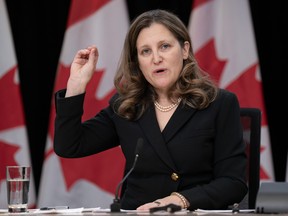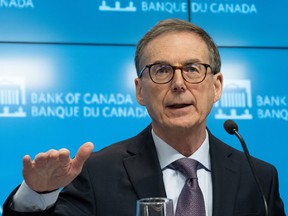Canada’s Budget Deficit Raises Warnings for Finance Minister
How Canada Could Meet Its Deficit Goals
-
Desjardins Predicts $47 Billion Deficit: Financial institution Desjardins has projected that Canada could face a significant shortfall in its budget, potentially reaching up to $47 billion if current spending trends continue. This projection comes at a time when the country is already grappling with record levels of debt and operating expenses.
-
Chrystia Freeland’s Challenge: Finance Minister Chrystia Freeland has been tasked with navigating this complex landscape, ensuring that Canada maintains its position as a responsible fiscal nation. Her ability to balance spending with revenue will be crucial in preventing a deeper deficit.
The Fiscal Landscape: Warnings from Analysts and Experts
-
Analysts’ Projections: A chorus of economists and financial analysts warn that without significant measures to control expenditures or increase revenues, Canada is on track to fall short of its budget targets. These experts emphasize the need for immediate action to address the deficit.
-
Economic Growth’s Role: The recent economic growth at the start of 2024 is seen as a potential lifeline. If this momentum continues, it could help offset some of the pressures on revenues and stabilize the fiscal outlook.
Potential Solutions and Challenges
-
Business Groups Concerned: Canadian business leaders have expressed alarm over the risks associated with maintaining current spending levels without corresponding revenue increases. This sentiment has led to calls for a more aggressive approach to fiscal management.
-
Tax Hikes and Government Image: The specter of potential tax hikes looms large, particularly from provincial and territorial authorities. Business groups are increasingly pressuring Ottawa to avoid raising taxes, as they fear it could damage Canada’s reputation on the international stage.
Exploring Sustainable Fiscal Pathways
-
Savings and Asset Sales: One potential pathway forward is through savings and asset sales within the federal coffers. This strategy has been mooted by analysts like Desjardins, who suggest that increased revenues could help offset current deficits.
-
Strategic Savings and Investments: Beyond simple savings, there may be opportunities for more targeted fiscal measures. For example, investing in long-term infrastructure projects or other assets that could yield returns over the coming years.
Debt and Fiscal Health: A Closer Look
-
Comparison with Global Context: In comparison to other advanced economies, Canada’s debt levels appear relatively manageable. However, its triple-A credit rating remains under threat from ongoing deficits and rising debt.
-
Clean Energy and Sustainable Development: The push for clean energy initiatives and sustainable development projects could serve as a model for achieving long-term fiscal stability while driving economic growth.
Conclusion: Navigating the Fiscal Turmoil
-
Staying on Course: As Canada faces significant challenges, it will be crucial for Finance Minister Chrystia Freeland to maintain momentum. The ability to balance spending with revenue, coupled with strategic savings and investments, will determine whether the country can meet its budget targets.
-
Long-Term Outlook: For now, the immediate focus must be on stabilizing the fiscal situation while exploring innovative approaches to sustainable growth. With careful planning and execution, Canada has the potential to emerge from this challenging period with a stronger financial foundation.
This analysis provides a comprehensive overview of the current fiscal challenges facing Canada and explores potential pathways for achieving long-term stability.



